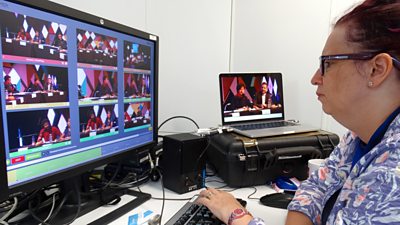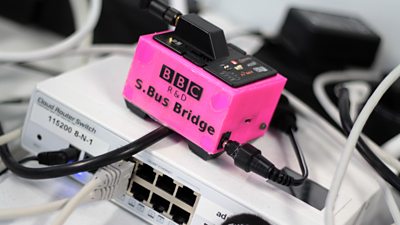
For the next in our end of year review series, 成人快手 R&D's Pete Brightwell takes a look at our work on end-to-end broadcasting via IP this year.
Object-based production and broadcasting
Modern development tools make it easy to with ideas for object-based media, but we also need some consistency on what those objects are and how tools should work with them. During the year we have created the Media Access API and which build upon IP Studio's to allow content to be managed and combined at a higher level and in a straightforward manner, something that traditional Edit Decision Lists certainly weren't designed for.
IP Studio's approach to object-based content is now being used by other projects:
The project is investigating how to provide low-cost coverage of live events. The project's PRIMER application now makes use of IP Studio's technology for live capture, and UMCP to represent the director's edit decisions. It was successfully used at this year's and

- The European project is researching object-based audio, and is using IP Studio鈥檚 technology framework and its Universal Media Composition Protocol (UMPC) to underpin the development of its production system.
- The project is using objects as part of an immersive experience for audiences, most recently for the .
Meanwhile, the team is continuing to develop our model and technolgies to support the requirements of future project work.
- Sign up for the IP Studio Insider Newsletter:
- Join our mailing list and receive news and updates from our IP Studio team every quarter. Privacy Notice
- First Name:
- Last Name:
- Company:
- Email:
- or Unsubscribe
Industry developmentsA year ago there were a number of different proposals competing for the next generation of industry specifications for transport and synchronisation over IP. Although this is still to some extent so, we are pleased to report that some parts of the approach that we have advocated based on our research, namely elemental flows of video, audio and data as RTP streams which can be synchronised using a common clock based on the Precision Time Protocol, are gaining support with manufacturers, and are expected to be formalised as the 2110 series of specifications.Last year, the set up the Networked Media Incubator, to enable the industry to work together on developing "the next layer of specifications", such as how devices can be discovered, connected and controlled using IP. So far, 成人快手 R&D have been central to much of the activity of the group, and we have run , with a third workshop held at in Germany. This has led to the development of , based on IP Studio's work, and the first of a family of "" (NMOS). Unlike "traditional" broadcast standards, which are developed behind closed doors and then published, NMOS specifcations are made public as soon as is feasible, more in line with how the .
As the change from "traditional" broadcast to IP-based technologies can seem quite a challenge to broadcasters, many of the leading manufacturers have come together to to create the , to present a roadmap for migration, based on the work of SMPTE, VSF, AES and AMWA, which in turn have taken inspiration from 成人快手 R&D's input.

All these groups came together at to put on a high profile showcase of recent progress in the . About forty manufacturers (as well as us!) demonstrated systems working together on transport, timing and discovery.
We are working with other teams within the 成人快手 to advise on what all this means to future IP facilities. Of particular note here is plans to move to a new site in central Cardiff; the aim is that this will have IP at its core and this core will make use of the specifications that have come out of our engagement with industry.
A cloudy futureAlthough there was plenty of IP happening at IBC, what visitors saw on the exhibition floor wouldn't have looked that different to a few years ago, with dedicated pieces of equipment now featuring network connections. However, visitors were starting to hear more about virtualisation, where some of those pieces of equipment could be deployed on demand in a data centre -- which might be on their own premises or owned by a cloud provider. The broadcast industry (including 成人快手) is already making significant use of virtualisation and cloud computing for distribution over IP, and also in the post-production industry, but it's still quite rare for live/studio production, and raises questions of how to deal with the vast quantities of real-time content efficiently.To help us inform the 成人快手's future strategy on virtualisation, we have built a test-bed at our . This based on and other open-source technologies, and allows us to deploy IP Studio components on demand within a virtual machine or software container. The aim is to support both provisioning productions at scale within a data centre, on on location at events ("cloud-in-a-box").
- -
- 成人快手 R&D - High Speed Networking: Open Sourcing our Kernel Bypass Work
- 成人快手 R&D - Beyond Streams and Files - Storing Frames in the Cloud
- 成人快手 R&D - IP Studio
- 成人快手 R&D - IP Studio: Lightweight Live
- 成人快手 R&D - IP Studio: 2017 in Review - 2016 in Review
- 成人快手 R&D - IP Studio Update: Partners and Video Production in the Cloud
- 成人快手 R&D - Running an IP Studio
- 成人快手 R&D - Building a Live Television Video Mixing Application for the Browser
- 成人快手 R&D - Discovery and Registration in IP Studio
- 成人快手 R&D - Media Synchronisation in the IP Studio
- 成人快手 R&D - Industry Workshop on Professional Networked Media
- 成人快手 R&D - The IP Studio
- 成人快手 R&D - IP Studio at the UK Network Operators Forum
- 成人快手 R&D - Covering the Glasgow 2014 Commonwealth Games using IP Studio
- 成人快手 R&D - Investigating the IP future for 成人快手 Northern Ireland
-

Automated Production and Media Management section
This project is part of the Automated Production and Media Management section
